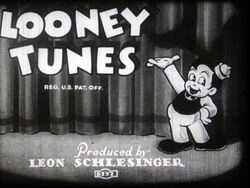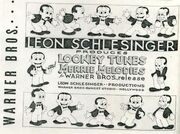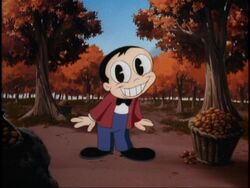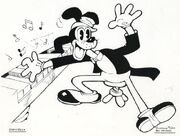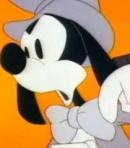Before there was Mickey Mouse, Walt Disney had a rabbit.
Previously, Walt Disney made a series of live-action/animation hybrid short films called the Alice Comedies. They focused on a young real-world girl who ventured into the cartoon world where she had lots of adventures. However, after three years, the series was discontinued due to money constraints.
There was a need for a new series of cartoons. Disney’s distributor, Charles Mintz, told Disney about how the studio Universal, wanted to release cartoons. A deal was made with Universal, and Oswald the Lucky Rabbit was created.
The first cartoon in the series, Poor Papa, depicted Oswald as being old and tired. The bosses at Universal did not like the short and the portrayal of Oswald, and therefore, Disney made a new one, Trolley Troubles, where Oswald was depicted as being much more young, spirited, and energetic. This cartoon was released in 1927, whereas Poor Papa did not see the light of day until 1928.
Oswald became very popular, and he was even the first character created by Disney to be made into merchandise.
However, things would not be this way forever.
When time came to negotiate a new contract with Charles Mintz, Disney asked for a 20% budget increase in order to improve the quality of animation of his shorts. Mintz not only rejected his request, he said that Disney would have to accept a 20% budget decrease; the reason was financial constraints, but Mintz promised more money if things turned around. Then it got worse. Mintz revealed that he was already hiring away Disney’s staff as part of a new commitment. Since Walt Disney did not own the rights to Oswald, he had no choices other than to accept Mintz’s terms or to walk away.
Disney finished his contract, and he left, accompanied by only a small number of his former staff including, most importantly, Ub Iwerks. Disney vowed to make sure that he works for nobody other than himself, and he also made sure that he owned the rights to whatever characters he created so that no matter what, nobody could stop him from making cartoons with those characters. Disney and Iwerks created Mickey Mouse, and the rest is history.
Meanwhile, Mintz oversaw the production of more Oswald cartoons. Some of his staff included other men who were instrumental in the history of animation including Hugh Harman, Rudolf Ising, and Friz Freleng.
Then things went south.
After Mickey Mouse appeared in the first cartoon with synchronized sound, Steamboat Willie, which of course was a huge success, Universal was angry that he had allowed Disney to walk away.
Mintz attempted to get Disney to come back. But Disney refused to accept his terms. The terms were hardly any better than the previous terms that he previously offered Disney. The terms would be that Universal would own Mickey Mouse, Disney would get a small increase in pay, and a lack of control over his staff. Disney said no. Oswald cartoons eventually moved to sound, but that Universal later fired Mintz and his studio in 1929, and they hired Walter Lantz to make more cartoons with Oswald. Mintz would find a new home making cartoons for Columbia Pictures
Lantz changed the course of Oswald, making his shorts more and more driven by fantasy. Eventually, as Disney created his signature style of being very cute, Lantz tried to emulate it, but Oswald gradually lost his popularity, being phased out in 1938.
Oswald was revived in 1943, in a short film called The Egg-Cracker Suite, but this attempt was a failure because Oswald was depicted as being very cute, when by that time, most audiences favored abrasive, assertive cartoon characters such as Bugs Bunny, Daffy Duck, Universal’s own Woody Woodpecker, among others. This was his last appearance in a theatrical cartoon, except for a cameo in a 1952 Woody Woodpecker cartoon.
Fast-forward to 2006. The Walt Disney Company negotiated with NBCUniversal for the rights to Oswald. By trading sportscaster Al Michaels to NBCUniversal, Disney got in exchange, the rights to the Oswald character and the surviving Disney Oswald cartoons.
The cartoons were released in December of 2006 under the Walt Disney Treasures collection (Only 13 shorts were known to exist at the time, but two more were discovered since then). Oswald began appearing in videos games, Disney theme parks, and even in short films (2013’s Get a Horse). This is a happy ending for a Disney’s very first cartoon star.
Sources:
http://en.wikipedia.org/wiki/Oswald_the_Lucky_Rabbit
http://tvtropes.org/pmwiki/pmwiki.php/WesternAnimation/OswaldTheLuckyRabbit?from=Main.OswaldTheLuckyRabbit

